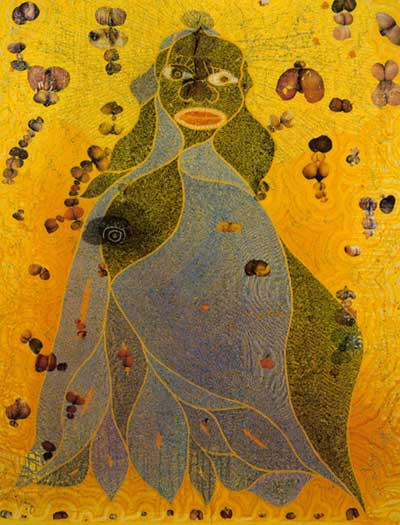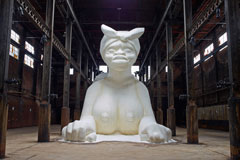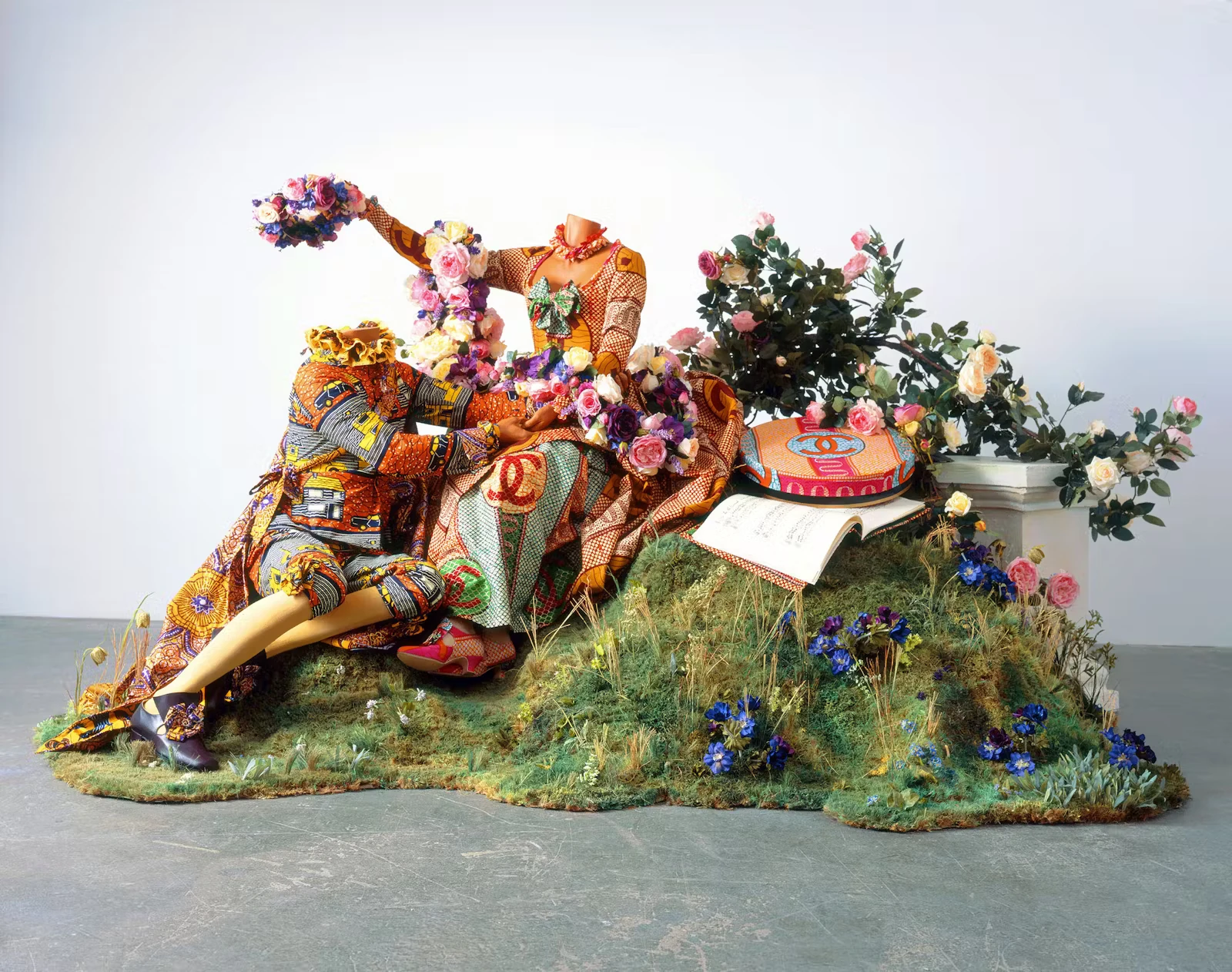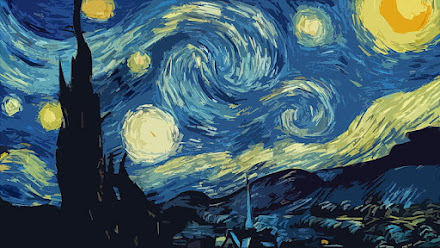The Impact of Globalization on Postmodern Art and Identity
The Impact of Globalization on Postmodern Art and Identity
Postmodern art isn't just about pushing the boundaries of what we consider "art"; it's about capturing the complexity of our rapidly changing, interconnected world. This exhibit explores how globalization has influenced contemporary art, particularly when it comes to issues of identity, culture, and the tensions or synergies between different worlds. The artists featured here engage with themes like race, gender, cultural appropriation, and the ways mass media shape our understanding of who we are and who we aspire to be. Globalization has made the world feel both smaller and more intricate, and these artists are offering their unique perspectives on how we navigate that paradox.
1. Chris Ofili – "The Holy Virgin Mary" (1996)
Chris Ofili’s The Holy Virgin Mary is bold and provocative in all the right ways. It takes a religious icon and turns it on its head, incorporating elephant dung, glitter, and magazine cutouts around a Black Madonna. Ofili’s Nigerian roots are front and center, as he plays with the mix of the sacred and the profane, while also challenging how race and religion have been represented in art, especially in the West. What I find compelling is how he uses these materials to speak to themes of identity, spirituality, and the collision of cultures in a globalized world. The vivid colors and intricate patterns draw you in, but it’s the contrast between the Virgin and these unexpected materials that really makes you stop and think. It’s as if Ofili is reminding us that what we consider sacred can be messy, complex, and deeply connected to a much larger narrative.
Why I Love It:
What I find so interesting about this painting is how it completely challenges our ideas of religious imagery and race. The materials Ofili uses aren’t just there for shock value. They force you to confront the uncomfortable truths of colonial history and how African culture has been "reinterpreted" in the West.
2. Shirin Neshat – The Lovers (1990)
Shirin Neshat’s The Lovers is part of a series that critiques the tension between Western ideals and Eastern culture, particularly around gender. In this striking image, two figures whom I think are lovers are covered in Persian calligraphy. There’s something haunting about this photograph. The couple feels intimate, yet the ink on their bodies creates a sense of distance, almost like a barrier. It’s a powerful metaphor for love in the context of political and cultural divides. Neshat uses the ink as a symbol of tradition, and you can almost feel its weight, as though it's both a form of separation and a link that binds them.
Why I Love It:
This piece is emotionally charged. The stark contrast of black and white gives it a timeless quality, and the ink on their skin makes me reflect on how we’re all marked by the cultures we come from. But it also speaks to how we’re constantly redefining ourselves in response to that heritage.
3. Cindy Sherman – Untitled Film Stills (1977-1980)
Cindy Sherman’s Untitled Film Stills is a true classic. In this series, she explores identity as something performative. Each photo shows her dressed as a character straight out of a 50s or 60s B-movie, and yet each persona feels both fake and strangely real at the same time. Sherman critiques the stereotypical roles women are often forced into roles that are everywhere in our media today, from TV to ads to social media. She’s essentially telling us that identity is a construct, something we put on like a costume.
Why I Love It:
I love how Sherman makes you question what identity even is. The photos are unsettling because they feel real, but you know they’re staged. She forces us to confront how much of what we call "self" is really just a performance.
4. Kara Walker – A Subtlety (2014)
Kara Walker’s A Subtlety installation is one of the most powerful pieces of art I’ve ever encountered. She created a massive, sugar-coated sphinx inside an old sugar factory, referencing the brutal history of slavery and the sugar trade. The work speaks directly to the exploitation that helped build the global economy. The sugar is sweet, but the history it symbolizes is anything but. It’s a painful reminder that everything we consume from sugar to oil has a history of violence and colonization behind it. What makes this piece so effective is how it forces us to think about how these systems continue to play out today.
Why I Love It:
The sheer scale of this piece is awe-inspiring, and it hits you in the gut. The contrast between the delicate sugar coating and the dark history it represents is impossible to ignore. Walker is saying: Let’s not forget the cost of everything we take for granted.
5. Yinka Shonibare – The People of the World (2005)
Yinka Shonibare’s The People of the World features mannequins dressed in Dutch wax-print fabric, which, despite its origins in Indonesia, has been culturally appropriated by Africa. Shonibare’s work challenges the concept of cultural ownership and identity in a globalized world. He highlights how cultures constantly borrow from one another and how trade and colonialism have blurred the lines of what we consider “authentic” culture. The vibrant colors and intricate patterns are beautiful, but they also remind us that nothing including identity is ever as simple as we think.
Why I Love It:
I find Shonibare’s work both visually stunning and intellectually stimulating. The fabrics are eye-catching, but the piece also prompts us to think about who owns culture and what happens when the lines between “mine” and “yours” become blurred.
6. Jeff Koons – Untitled (1992)
Jeff Koons often gets dismissed as a kitsch artist making works for the rich, but Untitled (1992) is a sharp commentary on consumer culture. It’s a shiny porcelain rabbit, so perfect and glossy that it looks like something you'd find in a luxury store window. Koons plays with the idea of art as commodity, suggesting that in the age of mass consumption, even art is just another product for sale. What makes this piece interesting is that it’s not just a critique of art; it’s a critique of consumerism itself, making us question what’s real and what’s just part of the brand.
Why I Love It:
I’m not always a fan of Koons, but this piece is effective. It’s playful, it’s shiny, and it really makes you think. I love how it takes something as absurd as a giant rabbit and turns it into a biting commentary on how beauty and value are increasingly manufactured in today’s world.
Conclusion
The art featured in this exhibit isn’t just about appreciating beauty; it’s about questioning the systems, histories, and identities that shape our world today. From Chris Ofili’s bold challenges to religious and racial norms, to Shirin Neshat’s exploration of gender and culture, these artists give us a lot to think about. Globalization has created a tangled web where cultures constantly borrow from each other, and our identities are more fluid than ever before. These artists capture that complexity, confronting us with uncomfortable truths about where we come from and where we’re headed.
References:
"Artist Shirin Neshat Captures Iran's Sharp Contrasts in Black and White." NPR, 18 May 2015, https://www.npr.org/2015/05/18/407671343/artist-shirin-neshat-captures-irans-sharp-contrasts-in-black-and-white.
"Chris Ofili: The Holy Virgin Mary." WikiArt, https://www.wikiart.org/en/chris-ofili/the-holy-virgin-mary-1996.
"Creative Time: Kara Walker." Creative Time, https://creativetime.org/projects/karawalker/.
"Modern Classics: Cindy Sherman, Untitled Film Stills." ArtLead.net, https://artlead.net/journal/modern-classics-cindy-sherman-untitled-film-stills/.
"New York Post-War Results, May 2019." Christie’s, https://www.christies.com/en/stories/new-york-post-war-results-may-2019-9800aae2fd4b4c95816b5bbe2ab5538c.
"Yinka Shonibare." Zarastro Art, https://zarastro.art/yinka-shonibare/.








Hi Lily, you've done an amazing blog post this week, as always. I absolutely adore Kara Walker – A Subtlety; the piece has a strong emotional story. I also think you did a great job connecting the pieces to your topic of art and globalization, particularly linking the Subtlety to the sugar and slave trade.
ReplyDeleteYou did such a great job and I love the pieces you chose. You had a great central theme for the postmodern artwork for the globalization theme. I really enjoyed the piece by Jeff Koons that you chose as it looks life like. You did a great explanation of the shapes and choices of material used for the sculptures. You did a great job this week. Questioning the systems of our world today was something very interesting that you chose to pursue. I love the way you said this looks like something would be in a luxury store because that’s what I thought as well. The shine adds a layer of realness to the piece.
ReplyDelete